Doug Feldmann - Gibsons Last Stand: The Rise, Fall, and Near Misses of the St. Louis Cardinals, 1969-1975
Here you can read online Doug Feldmann - Gibsons Last Stand: The Rise, Fall, and Near Misses of the St. Louis Cardinals, 1969-1975 full text of the book (entire story) in english for free. Download pdf and epub, get meaning, cover and reviews about this ebook. year: 2013, publisher: University of Missouri Press, genre: Non-fiction. Description of the work, (preface) as well as reviews are available. Best literature library LitArk.com created for fans of good reading and offers a wide selection of genres:
Romance novel
Science fiction
Adventure
Detective
Science
History
Home and family
Prose
Art
Politics
Computer
Non-fiction
Religion
Business
Children
Humor
Choose a favorite category and find really read worthwhile books. Enjoy immersion in the world of imagination, feel the emotions of the characters or learn something new for yourself, make an fascinating discovery.
- Book:Gibsons Last Stand: The Rise, Fall, and Near Misses of the St. Louis Cardinals, 1969-1975
- Author:
- Publisher:University of Missouri Press
- Genre:
- Year:2013
- Rating:4 / 5
- Favourites:Add to favourites
- Your mark:
Gibsons Last Stand: The Rise, Fall, and Near Misses of the St. Louis Cardinals, 1969-1975: summary, description and annotation
We offer to read an annotation, description, summary or preface (depends on what the author of the book "Gibsons Last Stand: The Rise, Fall, and Near Misses of the St. Louis Cardinals, 1969-1975" wrote himself). If you haven't found the necessary information about the book — write in the comments, we will try to find it.
During star-pitcher Bob Gibsons most brilliant season, the turbulent summer of 1968, he started thirty-four games and pitched every inning in twenty-eight of them, shutting out the opponents in almost half of those complete games. After their record-breaking season, Gibson and his teammates were stunned to lose the 1968 World Series to the Detroit Tigers. For the next six years, as Bob Gibson struggled to maintain his pitching excellence at the end of his career, changes in American culture ultimately changed the St. Louis Cardinals and the business and pastime of baseball itself.
Set against the backdrop of American history and popular culture, from the protests of the Vietnam War to the breakup of the Beatles, the story of the Cardinals takes on new meaning as another aspect of the changes happening at that time. In the late 1960s, exorbitant salaries and free agency was threatening to change Americas game forever and negatively impact the smaller-market teams in Major League Baseball. As the Cardinals owner August A. Busch Jr. and manager Albert Red Schoendienst attempted to reinvent the team, restore its cohesiveness, and bring new blood in to propel the team back to contention for the pennant, Gibson remained the one constant on the team.
In looking back on his career, Gibson mourned the end of the Golden Era of baseball and believed that the changes in the game would be partially blamed on him, as his pitching success caused team owners to believe that cash-paying customers only wanted base hits and home runs. Yet, he contended, the shrinking of the strike zone, the lowering of the mound, and the softening of the traditional rancor between the hitter and pitcher forever changed the role of the pitcher in the game and created a more politically correct version of the sport.
Throughout Gibsons Last Stand, Doug Feldmann captivates readers with the action of the game, both on and off the field, and interjects interesting and detailed tidbits on players backgrounds that often tie them to famous players of the past, current stars, and well-known contemporary places. Feldmann also entwines the teams history with Missouri history: President Truman and the funeral procession for President Eisenhower through St. Louis; Missouri sports legends Dizzy Dean, Mark McGwire, and Stan the Man Musial; and legendary announcers Harry Caray and Jack Buck. Additionally, a helpful appendix provides National League East standings from 1969 to 1975.
Bob Gibson remains one of the most unique, complex, and beloved players in Cardinals history. In this story of one of the least examined parts of his careerhis final years on the teamFeldmann takes readers into the heart of his complexity and the changes that swirled around him.
Doug Feldmann: author's other books
Who wrote Gibsons Last Stand: The Rise, Fall, and Near Misses of the St. Louis Cardinals, 1969-1975? Find out the surname, the name of the author of the book and a list of all author's works by series.

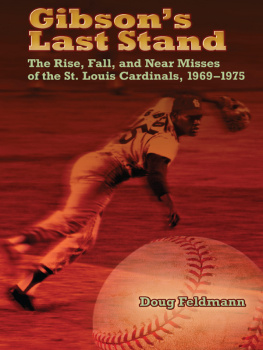

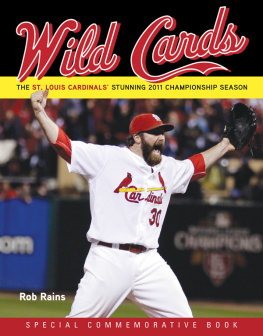
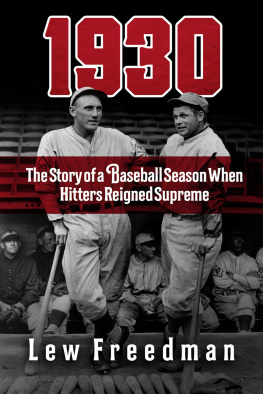


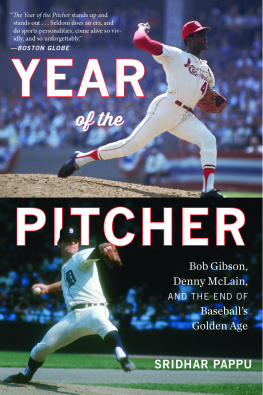

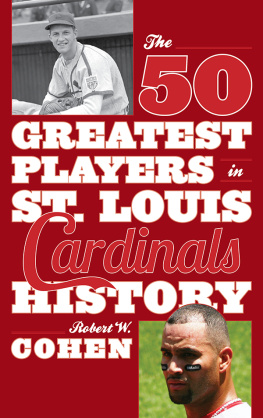
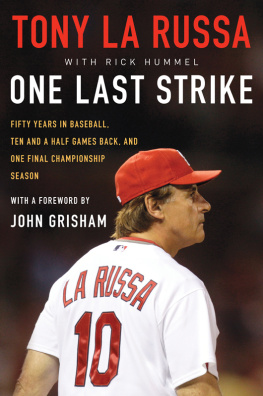

 This paper meets the requirements of the American National Standard for Permanence of Paper for Printed Library Materials, Z39.48, 1984.
This paper meets the requirements of the American National Standard for Permanence of Paper for Printed Library Materials, Z39.48, 1984.